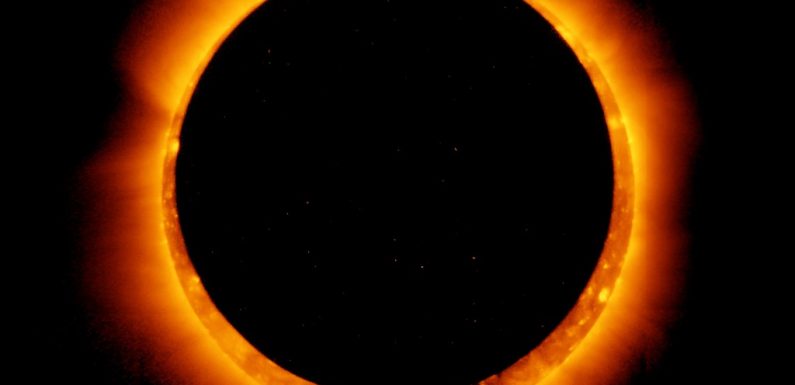
Imagine you’re at Mesa Verde National Park, considered a sacred place by many because of the ancient cliff dwellings that were home to ancestral Pueblo peoples for more than 700 years. Shortly after 9 a.m., the sun begins to shrink. An hour and a half later, a black circle all but obscures it.
If clouds don’t spoil the show, that will happen on Oct. 14 when an annular solar eclipse occurs in Colorado’s Four Corners area, including Mesa Verde, providing a spectacular sight that should top the list of best celestial events of 2023 for sky gazers.
An annular eclipse occurs when the path of the moon crosses the sun but the moon is too far from Earth to obscure the sun completely. The path across the United States where this eclipse will reach annularity — meaning the moment when the black disk of the moon will be ringed by the sun — will cross parts of Oregon, Nevada, Utah, Colorado’s Four Corners region and parts of New Mexico, including Albuquerque.
It will be visible in Denver, too, but not in annularity (the ring of fire around the moon).
“We will be treated to a nice partial solar eclipse,” said Ron Hranac, board member and past president of the Denver Astronomical Society. “During the maximum phase of this partial eclipse (in Denver), the sun will be about 78% covered by the moon. That will make for a nice display.”
You might want to order your eclipse glasses now, which are available online, because adequate eye protection is required to prevent permanent damage from retinal burns. “Suitable and safe” filters should be used for those watching with telescopes, Hranac said.
The last time we had a solar event like this was a total eclipse in 2017. That was partial in Denver but total in Wyoming. So many people from other states traveled there to see it that news reports estimated the number of visitors doubled the state’s population of less than 600,000.
“It was definitely the biggest one-day event in Wyoming’s history,” said a spokeswoman for the state’s tourism office.
A “super” blue moon in August
This year we will see a blue moon in August. Blue moons occur when there are two full moons in the same month, and in this case the moon will be full on Aug. 2 and Aug. 30. Both will be “super moons,” meaning they will appear slightly larger than normal because they are the two full moons of the year when the moon is closest to Earth.
Glimpses of Mercury
Some may enjoy gazing at Venus and Mercury this year when they reach “elongations.” They are the two planets closest to the sun, and elongations occur when planets appear farthest from the sun as viewed from Earth. That’s primarily interesting for viewing Mercury, which is smaller than Venus and farther away. Venus is a regular feature in our night sky and is bright, but Mercury usually appears only as a faint object, if at all. Still, when it is at or near elongation it may be bright enough to see.
“Mercury, most people have never seen,” Hranac said. “Most of the time you can’t see it because it’s too close to the sun. But when Mercury is at or close to elongation it’s easier to spot, right after sunset or right before sunrise. You can sometimes see it with the naked eye, but it’s usually pretty dim. I generally don’t have any problem seeing it with binoculars. It looks like a dim star, but if you look around, you don’t see any other stars because the twilight sky is too bright.”
Mercury will be at elongation, and possibly visible, just before sunrise in the eastern sky on Jan. 30, May 29 and Sept. 22, and just after sunset in the western sky on April 11, Aug. 10 and Dec. 4. Venus will be at its elongation after sunset on June 4 and before sunrise on Oct. 23.
A comet cometh this month
We may get to see a comet soon. Named C/2022 E3 (ZTF), its orbit will take it closest to the sun next Thursday, and it will make its closest approach to Earth the first few days of February. It’s hard to predict how visible comets will be.
“If nothing else,” Hranac said, “it might be a fuzz ball that can be seen with binoculars and telescopes.”
The Denver Astronomical Society is hoping it’s the star of the show when it hold its monthly open house on Jan. 28. Telescopes will be available for the public to use.
Notable meteor showers
There are several meteor showers that occur annually. The most notable usually are the Lyrids (peaking April 22-23), Perseids (Aug.12-13) and Geminids (Dec. 13-14).
Subscribe to our weekly newsletter, The Adventurist, to get outdoors news sent straight to your inbox.
Source: Read Full Article









